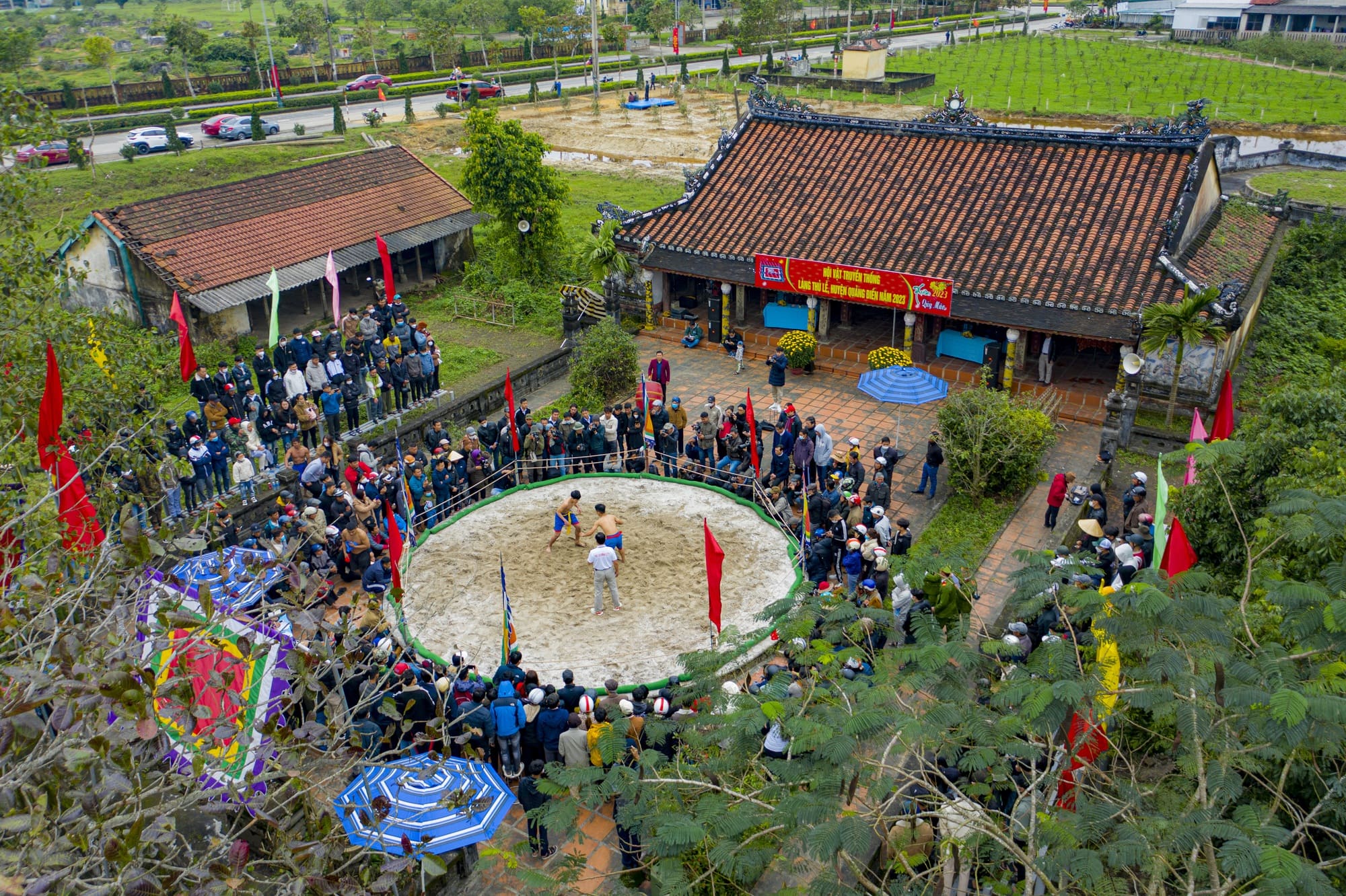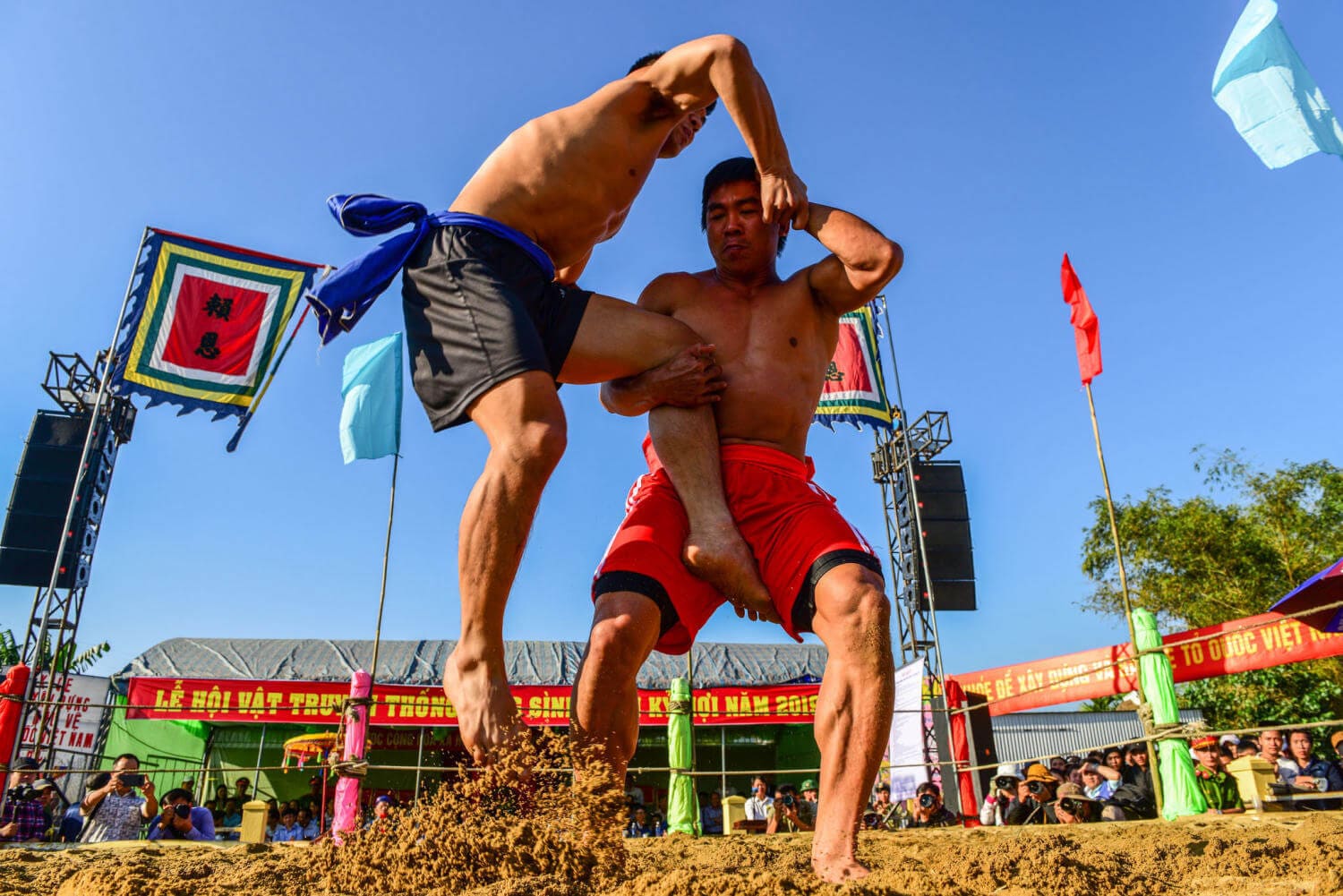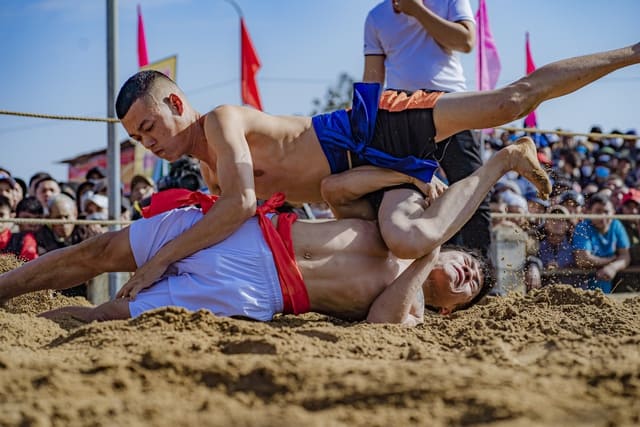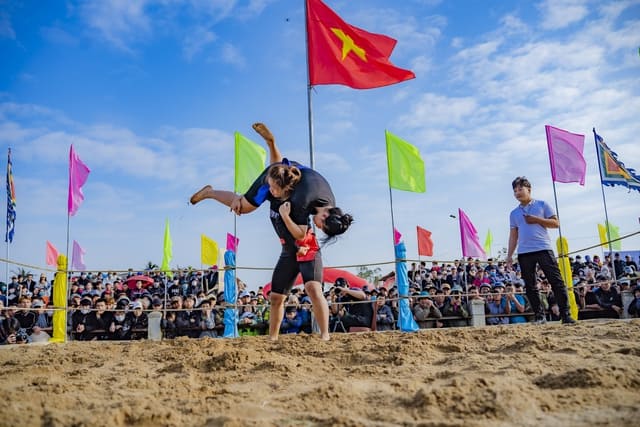
1. Origin of Sinh village wrestling festival in Hue
The wrestling festival takes place in Lai An, also known as Sinh village. This is one of the villages formed quite early in Dang Trong, located along the Perfume River, downstream of Sinh junction (procession in Tu Vinh district or Mau Tai canton), now Phu Mau commune, Phu Vang district, Thua province. Thien Hue. Sinh village is also the last address in the South that still preserves the martial arts tradition.

2. History begin
The traditional Sinh village wrestling festival has a history of more than 200 years and has developed continuously until now. This wrestling festival is completely different from the wrestling festivals in other villages because people organize the wrestling festival as a simple form of entertainment after the holidays, not for the purpose of selecting fighters for the feudal court at that time.
In ancient times, Sinh village was just an alluvial ground of three river branches merging together. The terrain here is flat and spacious, so it was used by the Nguyen lords as a place to practice martial arts for royal soldiers. When Lord Nguyen's court officials came here to practice martial arts, Sinh village had a young man who was fascinated with the wrestling moves of the generals so he joined the army.
After going through many battles, after the war ended, this young man returned to his village to get married and later introduced a form of wrestling for his children and grandchildren to practice together to improve their health. This person was later honored by the village as the founder of wrestling.

Sinh village's traditional wrestling festival has long become a big festival, a cultural feature with its own identity and deeply ingrained in the blood of every person in Sinh village. The wrestling festival is also a meaningful early spring playground, an interesting tourist destination for tourists every spring.
3. Characteristics
Sinh village wrestling festival, in addition to traditional spiritual elements, is also a fun and healthy activity full of martial spirit. Stimulates physical training, courage, confidence, and intelligence, especially for young men. The wrestling festival also aims to preserve the martial arts tradition - a typical cultural activity of Vietnamese people with the wish for healthy people, peaceful villages, lush crops, and happiness for all.

The unique feature of the Sinh village wrestling festival is that any audience can register to participate. Village rules stipulate that wrestlers do not have to be local, but any spectator can enter the wrestling ring. The Sinh village wrestling festival places great emphasis on martial spirit, so wrestlers are not allowed to make life-threatening attacks. Thereby, it also demonstrates the team spirit in the localities as well as an opportunity for wrestlers to practice throughout the year, cultivate ethics and wait for the beginning of spring to participate and compete. Regarding rewards, in addition to the Can prize for the championship, the village also awards prizes to all wrestlers participating in the competition.
4. What is Sinh village wrestling festival?
- Ceremony part
From early morning, the festive atmosphere was bustling, with the sound of drums, bright and colorful banners and flags. Onlookers and attendees were excited and jostling to create the heat of the festival. Sinh village wrestling festival has two parts: the ceremony part and the festival part and only takes place in one day. The ceremony was held quite solemnly at Lai An village communal house. Here, the elders in the village will perform a ceremony to pay their respects to the Thanh Hoang of the clan leader at the village communal house. Then the official meeting began.

- Assembly section
Wrestlers do not have to be local, any spectator can register to participate. The ring is a wrestling ring made of powdered clay, each width is about four or five arm spans, more than one meter high, with protective ropes on all four sides. The wrestler's handler wears a long black turban and controls the wrestling match with the intensity of the drum.

The referee is someone who understands the law, is sensitive and determined. Wrestlers wear pants and an additional belt around their waist. Before entering the official competition, the wrestlers will head to the ancestral hall and kneel down to bow 3 times according to the signal of the drum. This is also the difference between Sinh village wrestling and wrestling festivals across the country.
Sinh village wrestling festival basically also applies the principles of national wrestling competition rules. The rules stipulate: you must knock down your opponent in a "white on your back" position while holding or pressing the opponent for 3 seconds to win.
Because of the great emphasis on martial spirit, dangerous moves such as breaking and locking joints, attacks on the lower body, throat, eyes, etc. are completely prohibited at the wrestling meet. Wrestlers will be divided into age groups, and any wrestler who wins 3 matches will advance to the semi-finals. Only after passing the semi-finals will you be able to enter the final round.

Team spirit in the localities is very important. If a village capital loses, another village immediately steps up to support it. The first prize wrestlers receive areca, betel, wine, pig's head along with flags, medals and prize money.
Later, the association determines the rules depending on the number of wrestlers who make it to the second round, usually a knockout. With martial arts, in addition to health, wrestlers must also have technique and agility to hope to win. Objects with many beautiful and fierce pieces that are often used by wrestlers are armpits, ribs, beef pieces, groin pieces (reaching into the groin and then choosing an attack position), lifting the opponent to the ground, and armpits (armpits). back carry), burial piece (lifting the opponent up)...
An admired wrestler usually has well-proportioned limbs. Strong legs to stand firm, strong arms to knock the opponent down. But being big doesn't necessarily mean being strong, being strong doesn't necessarily mean winning. Therefore, you need to be quick, persistent and cunning to see the opponent's loopholes and take advantage of the golden opportunity in front of you.
Sinh village today is very different from before, but the ancient cultural space still retains clear traces of a martial land. These are testaments to the lasting cultural value of the people of Sinh village. This is also the impression that remains in the hearts of visitors when they set foot in this beloved land
